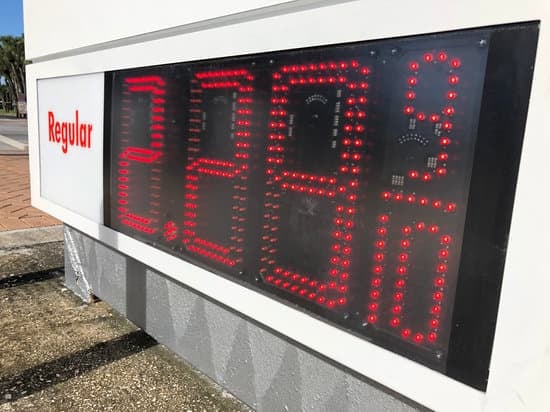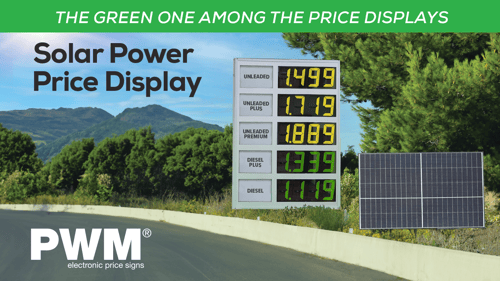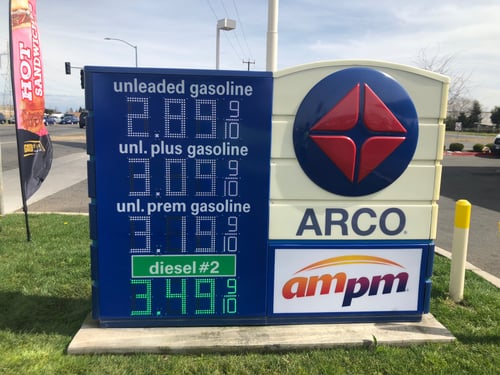
It took almost 50 years from the world’s first unofficial “road trip” in 1888 to what is considered the birth of the “modern” gas price sign in 1937. Quickly becoming a roadside staple, gas price signs are still going strong in 2022 as well-lit beacons that guide today’s drivers, both day and night.
“Electronic price signs are your first impression and can help motorists make that split-second decision to pull into your gas station,” said PWM President and CEO Wolfgang Manz. “Modern SMD LED technology can turn gas station price signs into a lighthouse for drivers with great visibility even in the harshest of conditions. Fog, rain, and snow are no match for the brightness and light quality of these electronic price signs.”
Not All Electronic Price Signs are Created Equally
All electronic price signs are not created equally as LED technology has matured over the years, offering up a variety of electronic price sign options from SMD LED to DIP LED to COB LED to GOB LED.
For those not up on their lighting acronyms, here is your LED cheat sheet:
- The two main types of modern LED downlights are surface mount diode (SMD) and chip on board (COB).
- You might also see dual in-line package (DIP) LED, which is considered the standard, older version of LED technology.
- Finally, glue on board (GOB) is an LED display technology that uses transparent epoxy glue to seal the module surface.
PWM helped revolutionize the market for electronic price signs with the first manufacturing of SMD LED digits in 2007.
“The modern SMD LED displays are slimmer, far easier to maintain, energy saving without the need for extra lighting, and they remain reliable even under the toughest conditions,” said Manz.
Gas Station Price Signs: Making a First Impression
Today’s gas station price signs have the important task of making a first impression for your brand.
Of course, in the early days of driving, motorists didn’t have service stations or price signs to guide them.
In 1888 when Bertha Benz – yes, her husband Karl was the famed German engineer! –went for a 60-plus-mile road trip from Mannheim to Pforzheim in her new Benz Patent-Motorwagen, she had to refuel by stopping at pharmacies for benzene.
According to the NACS “The History of Fuel Retailing”, the world would have to wait some time for other driving milestones after Benz’s historic road trip:
- Fill’er Up: The first drive-in gas station (though up for claim by other locations) is said by many to have been at the corner of Baum Blvd. and St. Clair St. in downtown Pittsburgh. Which opened on Dec. 1, 1913, with the Gulf Refining Co. selling 30 gallons of gasoline at 27 cents per gallon that first day, according to the Pennsylvania Historical and Museum Commission.
- Brother, Can You Spare a Dime? Gas station signs remained small until Maryville Oil Co. in Missouri put up its “The Big Pump” gas price sign in 1937 during The Great Depression that showed its prices per gallon from a distance to drivers. Those first per gallon prices? 7.9 cents for “white”, 9.5 cents for “bronze” and 11.5 cents for “ethyl”.
- A decade later, Texas-based The May Group designed the first changeable gas price signs, and the landscape was soon dotted with these highly visible “flip” price signs that could be changed via long ladders or poles.
Of course, in today’s rapidly changing world, nobody has time (or the insurance!) to climb a ladder to update gas station prices.
“When prices change, it’s really important to get them up as soon as possible, but it often takes two employees – with one needed to mind the store – and sometimes it just has to wait until shift change,” Jeff Lenard, NACS vice president of communications to the Savannah Morning News the year that PWM launched its SMD LED price signs. “LED is easier to see when you’re going down the road … besides LED signs just look so much better – especially to younger consumers who are more accustomed to texting than talking.”
How the Cutting-Edge SMD LED Technology Works
The cutting-edge SMD LED technology has many advantages of other types of electronic price signs including:
- Light Quality and Brightness
- Energy Efficiency
- Ease of Installation
- Ease of Maintenance
- Increased Viewing Angles
TechWalla explains the evolution: “Light emitting diodes (LED) date back to the early 1960s. However, for decades LEDs did not have many practical applications due to their manufacturing cost. Today, LEDs have cost-effective applications in everything from toys to luxury automobiles.”
SMD LED led the way by reducing the size of the light while at the same time adding more colors to a single LED.
“SMD LEDs mount on the surface of electronic boards but do not physically go through the boards like other types of LEDs,” said TechWalla. “Another important feature of SMD is miniaturization. Reducing the size of the LED makes it possible to place 3 LEDs of different colors in one unit. The three colors - red, blue, and green - create a smaller pitch. The pitch (or distance) between pixels affects the resolution and image quality of an LED display, such as a digital billboard. Using one LED to create three colors results in improved image quality.”
One LED provider says that the big benefit for outdoor displays is that SMD LEDs can provide a light source without taking up a significant amount of room inside the devices with the SMDs helping arrange light in tight groups, creating more colors and high-quality images.
PWM Keeps Innovating its Electronic Price Signs
PWM has continued to hone its SMD LED technology with the launch in 2014 of the first outline digits – two-colored digits that stand out from the single-colored digits.
A year later, PWM launched the first full-color digits – a combination of the basic colors red-green-blue (RGB) within an individual LED which allows millions of colors to be mixed.
The result is that PWM can offer customers high rise digits that feature light quality, increased viewing angle, great visibility from a far distance and cost-savings from energy efficiency and quick and easy installation.






